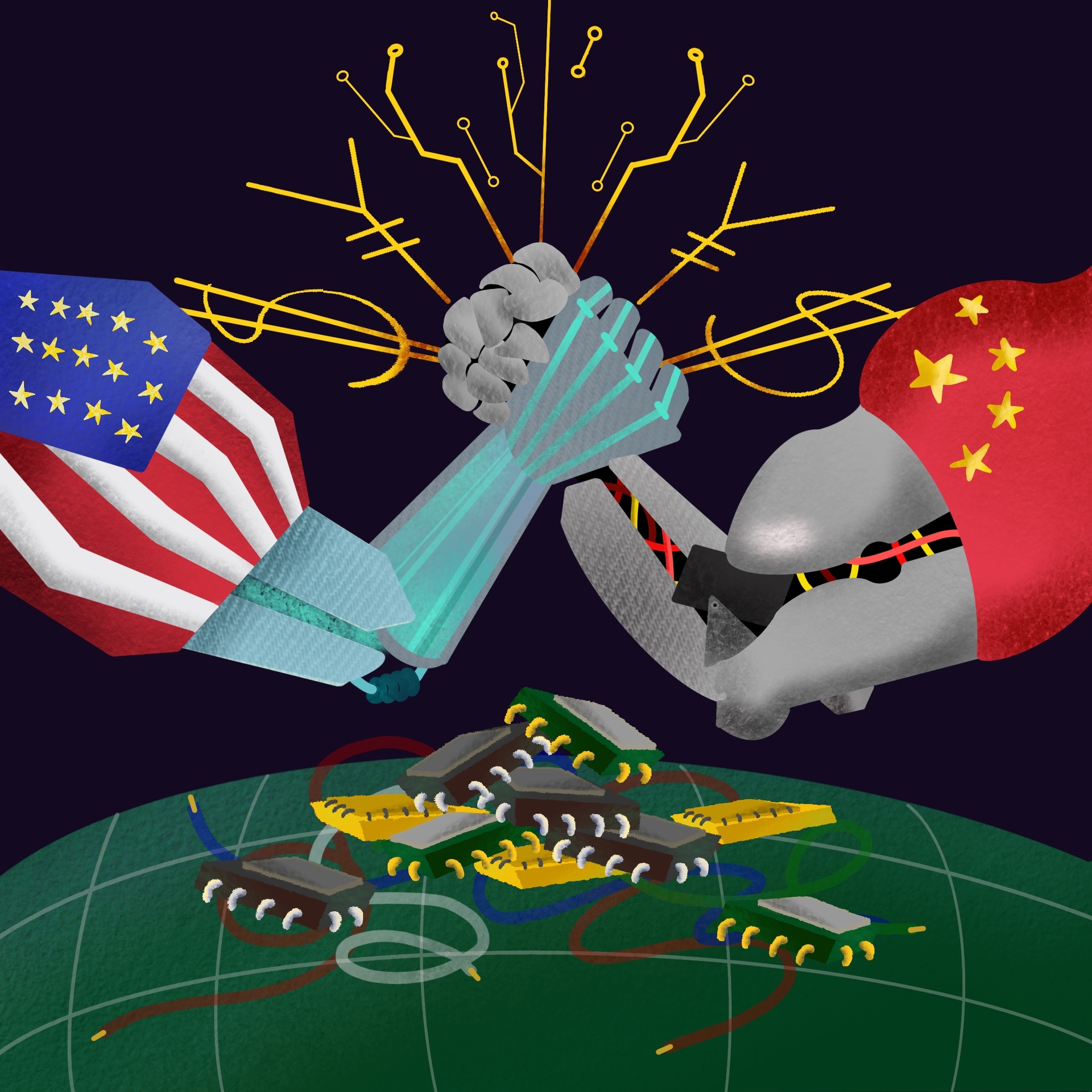The New Network Literature
A review of Daniel W. Drezner, Henry Farrell and Abraham L. Newman, eds., “The Uses and Abuses of Weaponized Interdependence” (Brookings Institution Press, 2021).

Published by The Lawfare Institute
in Cooperation With

A review of Daniel W. Drezner, Henry Farrell and Abraham L. Newman, eds., “The Uses and Abuses of Weaponized Interdependence” (Brookings Institution Press, 2021).
***
Networks are a fundamental aspect of international politics, but how to understand them has long bedeviled international relations scholars. As Robert Jervis cautioned in 1997, networks defy efforts to isolate single variables or focus narrowly on bilateral relations; the structure of the international network itself has its own influence on outcomes. To make matters even more complicated, network structure can be both a cause and an effect, and its influence on the actions of governments, international firms, human rights groups and terrorist organizations (among many others) is less deterministic than conditional. What do we do with all this complexity?
For much of the past two decades, the answer has generally been to set it aside as much as possible. But now that seems to be changing. Research employing network analysis not only is becoming more prominent in the field (including both qualitative and quantitative approaches) but also is increasingly engaging with renewed policy debates about great power competition. An important recent contribution is “Weaponized Interdependence: How Global Economic Networks Shape State Coercion,” Henry Farrell and Abraham Newman’s 2019 article in International Security, which introduced the concepts of panopticons and chokepoints in international networks. In the modern globalized economic system, states are connected through a dense network of commercial and financial ties. The authors noted that liberal theories of international politics argue that these linkages will deter war because open conflict would risk the collapse of interdependent systems, from supply chains to monetary systems. However, these connections are not equal, and central states and firms in these networks that operate as brokers and intermediaries have special advantages: First, they can serve as panopticons, observing the interactions between actors more clearly and directly than others, and second, they can operate as chokepoints, restricting network access to others to their own benefit.
To illustrate these network characteristics and how they can be “weaponized” by central actors, Farrell and Newman describe the U.S. role in the Society for Worldwide Interbank Financial Telecommunication (SWIFT), which facilitates international money transfers among banks. The outsized U.S. role in SWIFT has given U.S. law enforcement and intelligence agencies incredible insight into international financial networks and the power to disrupt them to Washington’s benefit. After 9/11, intelligence gleaned from SWIFT (the panopticon effect in action) allowed the United States to target organizations providing funds to terrorist groups, and in 2012, the United States and Europe coerced SWIFT to act as a chokepoint to cut off Iranian banks from the financial network, a crucial aspect of the international sanctions campaign against Iran’s nuclear program.The panopticon and chokepoint effects, Farrell and Newman argued, have applications in a range of contemporary international networks and will be key weapons in the escalating global competition between the United States and its rivals.
Now Farrell and Newman are back with an edited volume, with Daniel Drezner joining as a third editor. “The Uses and Abuses of Weaponized Interdependence” reinforces their point with more compelling evidence and examples. The book is an approachable introduction to the concept and thoroughly demonstrates its policy relevance; it will be valuable to both academics and policymakers. While the book demonstrates the utility of these concepts, it also raises new questions about when and how they apply, and what comes next for the study of networks in international relations.
Is No Network Safe From Weaponized Interdependence?
The book is divided into six sections: an initial theory section (that includes a reprint of the International Security article), four sections that each drill down deeper on a specific application of the concept of weaponized interdependence, and a concluding section that explores critiques and possible extensions.
In the first of the application sections, Harold James and Thomas Oatley build on Farrell and Newman’s SWIFT example to expand the discussion of weaponized interdependence in global financial networks. Situating his discussion in the context of the European debt crisis, James offers a historical example, considering how the emergence of central banks, especially in London, to manage the flow of bills of exchange in the late 19th century prefigured modern networks such as SWIFT and Europe’s TARGET2 system for settling inter-Eurozone transfers among central banks. Oatley further develops Farrell and Newman’s description of the United States’ use of its centrality in contemporary financial networks to enact sanctions. He also considers how weaponized interdependence can help explain why sanctions were successful first in targeting terrorist organizations and then compelling Iran to negotiate over its nuclear program but have been less effective when leveled at more powerful revisionist powers like Russia.
Turning to the tech sector, Natasha Tusikov casts private U.S. tech platforms as an interrelated hub for the internet, which is only just starting to see a growing counterweight from Chinese firms. The companies that dominate payment services, advertising systems, domain name providers, and online marketplaces each have panopticon-like insight into online activity and can act as chokepoints to close off funding and website hosting to certain actors. Tusikov points to the example of WikiLeaks, which, in response to U.S. pressure, had its main streams of funding cut off (when payment processing firms stopped working with the company), its website domain revoked, and its cloud storage disabled by Amazon. Adam Segal focuses on the U.S.-China competition over the provision of 5G infrastructure and the potential national security threats involved. In this instance, the emerging dominance of Chinese firms Huawei and ZTE could represent a new central node in internet networks, providing China with panopticon and chokepoint advantages. But, Segal notes, the U.S. response has been to employ its own chokepoints: going after Huawei’s chief financial officer for sanctions violations, pressuring partners and allies to stay onside and not invest in Chinese 5G technology, and restricting Chinese access to supply chains that provide necessary components.
Energy networks are another interdependent field of competition. Emily Meierding breaks energy networks into several interrelated systems, noting that, while the United States is not dominant in the production and sale of energy resources, it compensates for that lack of centrality in energy networks with its centrality in providing secure commercial shipping and facilitating energy trade through the SWIFT system and dollar-based exchange. The result is that, although the United States would have difficulty weaponizing the energy market unilaterally or even multilaterally, it is not in a position to be coerced either. Mikhail Krutikhin looks at Russia’s regional energy dominance in Europe and its efforts to use its position “for power mongering in former Soviet republics and beyond the ex-Soviet borders” but concludes that these efforts have been undermined by Europe’s responses to Gazprom’s provocations, new efforts to diversify Europe’s energy supply, and Russian oligarchs’ own greed that has at times come at the expense of Gazprom’s prospects.
Finally, a pair of chapters consider specifically state-managed networks. Florian David Bodamer and Kaija E. Schilde compare the U.S. decision to cut Turkey out of the F-35 program and the German-led decision to block sales of the Eurofighter to Saudi Arabia. The cases illustrate that even relatively symmetric networks can be leveraged by key actors for coercive purposes, but that doing so can come with higher costs. For instance, the required shift to new producers for F-35 components previously produced in Turkey will likely cost upward of $1.5 billion and shorten the lifespan of the weapons system, and Germany’s assertiveness has rankled France and the United Kingdom and may affect European cooperation on future major weapons projects. Thomas Cavanna tackles the biggest example of Chinese efforts to construct and leverage an asymmetric network of its own, the Belt and Road Initiative. China’s investment in electrical grids and nuclear power projects across Asia and into parts of Europe and its promotion of Chinese-produced 5G technology could give China a wealth of intelligence about strategic infrastructure. Cavanna also points to China’s potential chokepoints—in particular, with the proliferation of Chinese-controlled ports around the world and Chinese-supported roads and railways through much of Asia, Beijing could cut off countries or firms from access to commercial freight networks, though doing so would likely have serious economic and reputational consequences.
These issue-specific chapters provide a sample of the wide array of networks to which the concept of weaponized interdependence can be applied. Taken together, they paint a portrait of U.S. hegemony, at least on its face. Over and over again, it is the United States’ uniquely central position in financial, technological and security networks that grants Washington the power to enact coercive policies. It’s not entirely clear how effective these policies are—in the concluding section, Bruce Jentleson, for example, suggests that Farrell and Newman’s focus on metrics of state power pays insufficient attention to influence and whether these policies actually achieve their desired outcomes, and Amrita Narlikar discusses the ways that states can resist network coercion. But regardless of effectiveness, coercive U.S. policies do not seem to have significantly shaken Washington’s position at the center of these interdependent international networks. Several chapters return to the role of the SWIFT network, as well as the foundering efforts to circumvent it. For instance, Russia and China have both individually and jointly dabbled in building alternative payment processing channels, with limited success. And, although Europe established a separate vehicle for transactions with Iran to circumvent U.S. sanctions reimposed by the Trump administration when it withdrew from the Joint Comprehensive Plan of Action, many European companies nevertheless withdrew their business from Iran and the European network has not been used in transactions with other countries. The discussion of these revisionist policies only underscores the ways that the U.S. advantage, largely through SWIFT and U.S. dollar-denominated finance, has been resilient to potential challengers. In the theory section, Stacie E. Goddard discusses the ways in which revisionist states—namely China and Russia—can attempt to carve out more influence in U.S.-dominated networks that tilt the balance of power more in their favor, but these seem to be limited regional shifts, not the dislodging of the United States or the unraveling of U.S.-dominated networks.
The Big Picture
A key question remains at the heart of the book: What causes the erosion of asymmetric advantages in interdependent networks? Is it their weaponization by hegemonic actors, or just the existence of hegemonic actors in these networks in the first place? James argues that a hegemon’s frequent recourse to panopticon and chokepoint advantages will prompt other states to create alternatives that diminish the asymmetry of the network. “The nemesis of hegemony used to be overextension; now it is overuse,” he writes. Perhaps that might accelerate balancing in these interdependent networks, but that would almost certainly be occurring regardless. The example of Europe’s development of a channel to maintain financial ties with Iran, however limited, provides some evidence that abuse of weaponized interdependence can weaken the U.S. position even among its partners. But other examples, like China’s Belt and Road Initiative and its development of new international organizations that dilute the influence of the postwar institutions in which the United States exercises the most power, seem like the types of expansion that would be expected from a rising power regardless of U.S. weaponization. The implicit capability of the United States to act as a panopticon or chokepoint should be sufficient to prompt others to rebalance. So far, the emerging weaponized interdependence literature is inconclusive about the extent to which the “abuse” of interdependence advantages actually undermines hegemonic actors and how much is a more general shift in the relative distribution of national power.
This is a pretty realist critique of one aspect of the book, but the theory itself is pretty realist. Drezner, Newman and Farrell introduce weaponized interdependence at the start of the volume as a rejoinder to the pie-in-the-sky idealism of liberal theories that posit that economic interdependence creates mutual benefits that make it self-sustaining and military conflict too costly to consider. This, I think, caricatures most of the literature on interdependence. Even the theorists who are most responsible for proposing that interdependence in the international system can promote peace and be self-perpetuating baked competition into their concept of “cooperation.” As Robert Keohane wrote in “After Hegemony,” one of the landmark books in the literature:
To analyze the relationships between hegemony and cooperation, we need a conception of cooperation that is somewhat tart rather than syrupy-sweet. … [C]ooperation should be defined not as the absence of conflict—which is always at least a potentially important element of international relations—but as a process that involves the use of discord to stimulate mutual adjustment.
Cooperation in international politics involves competition. In Keohane’s definition, what makes it cooperation is that the process of equilibration yields a new compromise policy—though that might not necessarily be an even compromise among the actors involved. Weaponized interdependence provides useful concepts for understanding how states can use their structural position to coerce others—but as long as it is short of armed conflict, this seems like part of the process of jockeying for that eventual compromise position. In this respect, the authors may somewhat overstate their critique of the literature on interdependence.
Returning to liberal theories of interdependence raises a serious concern that goes underexplored in the book. Seeing great power competition through the lens of weaponized interdependence shows us, in effect, revisionist powers nibbling at the edges of U.S. hegemony. Many of the chapters describe the threat to U.S. power posed by Washington’s use of network panopticons and chokepoints in ways that alienate other states in the network. This is described mostly in terms of the reduction to U.S. centrality in these networks—that the networks could become more symmetrical. But examples like Russian and Chinese efforts to build their own dedicated currency clearing platforms and the Belt and Road Initiative’s potential to act as a parallel and exclusive commercial transportation network suggest a situation in which networks are not all that much less symmetric but significantly less interdependent. Taking liberal theories of interdependence seriously, and especially those that consider the “capitalist peace,” that should be a big concern. Not only does the introduction of new, distinct networks create new points of competition, but it also reduces the interdependence that inhibits military conflict by raising its cost.
Next Steps for Networks
The new literature on weaponized interdependence and its key concepts of panopticon and chokepoint advantages provides innovative ways of considering old questions about how states pursue policies in interdependent systems. As Farrell and Newman state, they’re drawing here on “sociological and computational research on large-scale networks,” and in particular they’ve homed in on one aspect. In the parlance of the network literature, they’re focused on the structural characteristics of nodes with disproportionately high “betweenness centrality”—a measure of the significance of a node as a “broker” between other, disconnected nodes. This is clearly a fruitful starting place, but it also opens the door to the application of other network characteristics to the study of the international system. This is already happening in some of the academic literature and has been advocated by some international relations scholars for more than a decade, but Farrell and Newman’s contribution demonstrates how these sometimes convoluted concepts can be translated and applied to the international relations context clearly and approachably, with direct policy implications.
The conclusion of the book demonstrates this potential. In a particularly interesting chapter, Charli Carpenter extends the application of weaponized interdependence from its focus on economic and technological networks to the ideational network of human rights, international law and international norms. She argues that the United States, among other states, is an ideational hub that has weaponized its central position to shift the meanings and definitions of human rights over time. But she also notes that weaker, less central states may have more power to resist these shifts than in other interdependent networks, and the disproportionate scrutiny dedicated to ideational hubs like the United States creates a sort of “reverse panopticon” effect. In their conclusion, Farrell and Newman express some concern about weaponized interdependence being stretched to new domains that they did not originally intend, but even if some of these applications require new terminology or frameworks, they illustrate the potential of network applications to policy-relevant scholarship. That’s a literature I’d like to see and read more.




